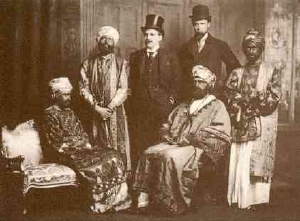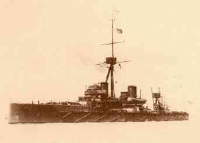
"The Emperor of Abyssinia" and his suite
From left to right: Virginia Stephen (Virginia Woolf), Duncan Grant, Horace Cole, Anthony Buxton (seated), Adrian Stephen, Guy Ridley.
On February 7, 1910 the Prince of Abyssinia and his entourage were received with full ceremonial pomp on the deck of the H.M.S. Dreadnought, the British Navy's most powerful battleship. Although the Commander-in-Chief of the Dreadnought had only received a last-minute warning of the Prince's arrival, he had the sailors standing at attention when the Prince arrived. The Abyssinian party acknowledged the greeting with bows as they shuffled onto the ship, dressed in their long, flowing robes, and for the next forty minutes the Commander gave them a guided tour of the vessel. The Abyssinians paused at each new marvel while murmuring the appreciative phrase "Bunga, Bunga!" in their native tongue. Finally the royal visitors departed as "God Save the King!" played in the background.
The next day the Navy was mortified to learn that the party they had escorted around the warship had not been Abyssinian dignitaries at all. Instead it had been a group of young, upper class pranksters who had blackened their faces, donned elaborate theatrical costumes, and then forged an official telegram in order to gain access to the ship. Their ringleader was a man named Horace de Vere Cole, but the entourage also included a young woman called Virginia Stephen who would later be better known as the writer Virginia Woolf.

H.M.S. Dreadnought
By February 12 the British newspapers were full of the story of the stunt. "Bunga Bungle!" the
Western Daily Mercury trumpeted. For a few days the Navy was the laughingstock of Britain. Sailors were greeted with cries of "Bunga, Bunga" wherever they went. One newspaper suggested that the Dreadnought change its name to the Abyssinian.
Humiliated and furious, the Navy sent the warship out to sea until the episode blew over. It wanted to bring formal charges against the pranksters, but dropped the idea for fear that it would simply attract more publicity to the case. Finally it settled on a more informal punishment. In the style of British boarding-schools, the participants (though not Virginia Stephen) were each symbolically tapped on their buttocks with a cane. None of the participants went on to perpetrate any more hoaxes except for Cole, who was known throughout his life as an inveterate prankster.

Comic-book version of the Dreadnought hoax. Published circa 1945.
Links and References
- Stephen, Adrian. (1983). The Dreadnought Hoax. The Hogarth Press.




Comments